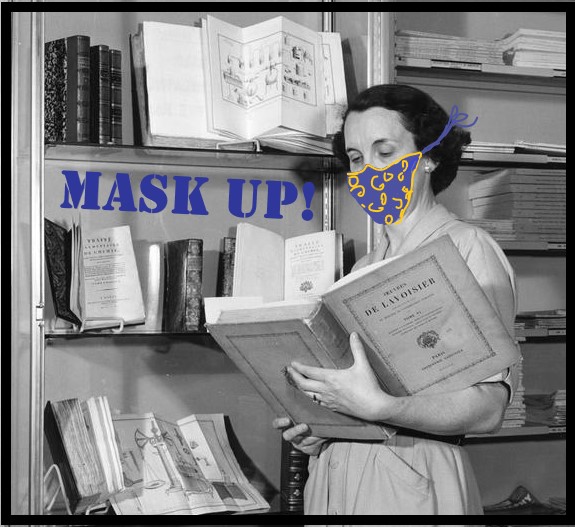
People have been spending a lot of time indoors for the past 11 months due to the pandemic. This has resulted in an increased interest in indoor air quality. For the most part, the discussion revolves around ways to lessen Coronavirus transmission by capturing particles or “disinfecting” the air. Proving the effectiveness of any method is difficult, and device manufacturers have made many claims. The problem is that these devices are not EPA approved and tested, and no ordinary consumer has the wherewithal to evaluate their efficacy. Even worse, many devices generate ozone, an oxidizer that accelerates damage to heritage collections and is a respiratory irritant. Exposure to ozone can make people more susceptible to respiratory illness. Additionally, the machines’ efficacy relies on the destruction of a sufficient number of virus particles, but the concentration of virus particles required to cause infection is still unknown.
The REALM project has been providing information and guidance for those of us in library and museum preservation. The project, conducted by the IMLS (Institute of Museum and Library Services) and OCLC, is overseeing the testing of library materials and estimating how long the virus is viable on surfaces like cloth, leather, plastics, paper, metal, and glass. It turns out that survivability is highly variable, depending on the type of material the virus lands on and whether that material is stacked or exposed to air. The SARS-CoV-2 (the virus that causes COVID-19) might maintain viability for only a day or for well over a week. The tests have not yet been repeated at different temperatures and humidity, and these are other factors that can influence. The current knowledge suggests that sequestration is the best action for possibly contaminated collections. That means segregating any item handled by a sick individual and keeping that collection item in quarantine for one to two weeks.
Discussions between library and preservation professionals have included how airflow and HVAC systems might be altered to reduce the virus's presence. The most straightforward practice is to increase the percentage of outside air directed through the air handlers. Unfortunately, this increases the amount of energy required to condition the air to museum standards or human comfort. Other methods include the use of ultraviolet lights (UVC specifically) to sanitize air moving through ductwork. There does not seem to be much current guidance on the efficacy of UVC radiation on the currently circulating coronavirus. UVC is known to destroy viruses, but only when it directly contacts virus particles; any dirt may block efficacy, and the ultraviolet light is harmful to the eyes and skin. Therefore, it cannot be used inside of an occupied space. Not to mention the fact that UV light is a primary agent of deterioration, causing fading of dyes, yellowing, and weakening of paper, and damage to organic materials. The UVC lights may be safely used if installed inside ducting. They can still produce ozone (O3) when the UV radiation breaks up oxygen molecules (O2), and they recombine. Professional installation and approval by an industrial hygienist are imperative.
Other devices sold as in-room air cleaners, deodorizers, and purifiers are often marketed as ion or hydroxyl generators. These machines use an electric discharge to produce either ozone or hydroxide ions. One commercial hydroxyl deodorizing system utilizes titanium dioxide in the presence of UV light and water to create free radicals that break down odor-producing volatile organic compounds. Unfortunately, these free radicals are equally capable of breaking down art and artifacts. The same photocatalytic chemical reaction is responsible for the deterioration of certain black and white photographs. In the late 20th Century, many photos printed on resin-coated paper (with an outer layer of polyethylene) were found with cracking and orange-colored image discoloration. These problems emerged on photographs on display. Studies revealed that the white titanium dioxide pigment in the photo substrate reacted with UV light to create free radicals, which broke bonds in the polymer plastic coating, leaving cracks. Peroxides and other oxidizers were generated and caused the deterioration of silver metal particles that form the black and white image.
This all reveals the current quandary of cultural institutions. There are no risk-free means of opening for visitation and researcher access. At Hagley, the approach is to maintain the practices recommended by health officials: stay apart, wear masks, clean surfaces, wash hands, and reduce occupancy. More advanced or aggressive attempts to disinfect the indoor environment are hazardous to our collection materials. The best prevention is to stay away from others if you are sick. It turns out that quarantine advice also applies to collections.
References:
Why aren’t ozone generators, UV lights, or air purifiers on List N? Can I use these or other pesticidal devices to kill the virus that causes COVID-19? United States Environmental Protection Agency
Ozone and Your Health. Airnow.gov. United States Environmental Protection Agency
Reopening Libraries Archives and Museums. IMLS, OCLC, & Batelle research project
UV Lights and Lamps: Ultraviolet-C Radiation, Disinfection, and Coronavirus. United States Food and Drug Administration
Wagner, Sarah S. An Update on the Stability of B+W Resin Coated Papers. Topics in Photographic Preservation, Volume 8. Pages: 60-66. Photographic Materials Group of the American Institute for Conservation of Historic & Artistic Works. 1999
Laura Wahl is the Library Conservator at Hagley Museum and Library.
